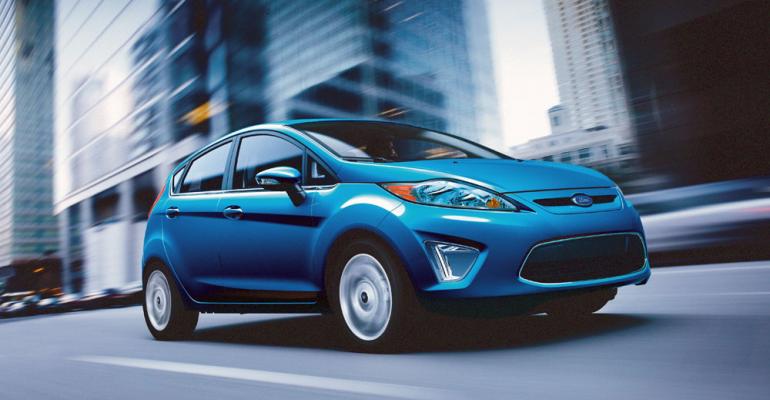DEARBORN, MI – The ’14 Fiesta, chosen as the first Ford vehicle in North America to receive the company’s new1.0L direct-injected turbocharged 3-cyl. EcoBoost engine, will be certified as the most fuel-efficient non-hybrid car available in the U.S., the auto maker says at a media event here.
Ford declines to reveal the car’s projected fuel economy, but says it easily will best the 29/39 mpg (8.1-6.0 L/100 km) city/highway rating achieved by the ’13 Fiesta, which is powered by a 1.6L 4-cyl. engine.
The 1.0L EcoBoost is available on a handful of European Ford products, including the Focus. Ford doesn’t reveal fuel-economy ratings for the model, but the European version of the Focus achieved a combined 39 mpg during a recent WardsAuto test drive.
The upcoming Fiesta with the 1.0L should improve on that number given that it is 450 lbs. (204 kg) lighter than the Focus.
Small-displacement, 3-cyl. engines have failed to gain favor among U.S. car buyers, despite their superior fuel economy, because of an inherent imbalance in the cylinder layout that leads to poor noise, vibration and harshness characteristics.
Bob Fascetti, Ford’s director-global engineering, admits the engine design “doesn’t have a sterling reputation,” but says the auto maker set out to fix the problem with a number of modifications.
Ford engineers added weights to the flywheel and front pulley to cancel out most shaking and developed motor mounts that absorb the energy and channel it in a less-sensitive direction.
The engine achieves “world-class levels of smoothness and refinement,” Fascetti tells media here. “It may be our smallest engine yet, but we focused on details.”
Ford also modified the engine to improve fuel efficiency, he says, by developing a split cooling system that cools the iron block and cylinder head separately, allowing the engine to warm up faster. An offset crankshaft reduces friction 3%-5%, while a variable oil pump controls oil pressure at the higher rpm range the small engine typically operates.
“The technology we’ve built into this engine is rewriting the book on what’s possible in a 3-cyl. engine,” Fascetti says.
The auto maker says the new technologies allow the 1.0L EcoBoost engine to develop nearly the same output as a 1.6L 4-cyl engine, but with 25% fewer moving parts, higher fuel economy and lower emissions.
The 1.0L EcoBoost in the North American Fiesta is projected to make 123 hp and 148 lb.-ft. (200 Nm) of torque.
“We really focused on reducing the amount of energy the 1.0L EcoBoost engine uses by paying very close attention to such things as bearing sizes, piston ring tension and thermal management,” Fascetti says.
While he defers questions regarding whether U.S. consumers will embrace a 3-cyl. engine, Fascetti does point to the success of the EcoBoost V-6 in the F-150 fullsize pickup, which has a take rate of 42%. “Even old truck guys recognize the saying, ‘There is no replacement for displacement’ is obsolete.”
Ford has not announced pricing for the ’14 Fiesta, but says it typically offers optional EcoBoost engines for about $995. The base price for the ’13 Fiesta is $14,200.





